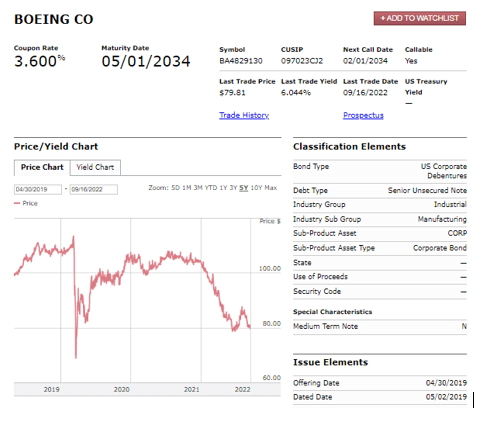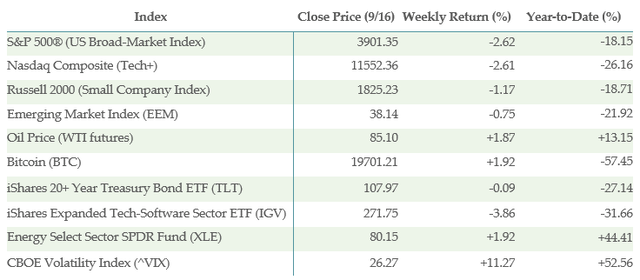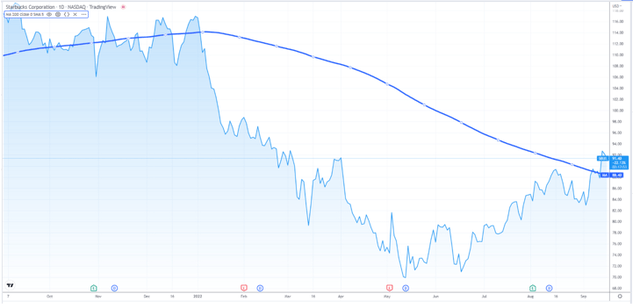Starbucks gave investors good news this week. Scott Olson
Brian Dress, CFA – Director of Research, Investment Advisor
Volatility has become a fact of life in markets over the past 12 months. We are hearing from investors lately a sense of unease, as they begin to grapple with an imminent recession and persistent inflation.
Over the last week, we have experienced yet another bout of volatility, as the Consumer Price Index for August came in with an inflation reading of 8.3%, higher than market analysts had expected. We have seen some anecdotal evidence from company earnings conference calls that prices have been cooling throughout the economy. However, we have not yet seen that play out in the official inflation data. On Tuesday we saw the worst trading day for the NASDAQ Composite Index since mid-2020, when markets were panicking on the back of the initial Covid outbreak.
As we have noted throughout the year, it’s not just the stock market that has been suffering. Interest rates have risen sharply in 2022 across the curve, as the Federal Reserve board has aggressively taken liquidity out of markets and increased the short-term discount rate. As a result, bond prices have fallen significantly and there has been really nowhere for investors to hide this year.
At Left Brain, we are always looking for the optimistic side of things, no matter how difficult markets seem to be at any given time. With falling prices in both stocks and in bonds in 2022, we certainly understand the concern investors are feeling. But with lower prices can often come opportunity.
For years, income-oriented investors have bemoaned the low interest rate environment, noting correctly that it was hard to build predictable income streams through high quality bonds and other fixed income instruments. With US Treasury Bonds paying 2% (or lower) at times over the last decade and A-rated corporate bonds in the 3% range, retirees have found it difficult for their portfolios to keep up with the typical 4% annual distribution. Investors were forced to purchase securities of lower credit quality even to approach a level of return sufficient to sustain their retirement income needs.
However, with interest rates rising, we are beginning to see higher quality investment-grade bonds that are yielding better than 5%. We don’t know how long rates will be as high as they are now, so we think now is the time for investors to lock in some of these higher yielding bonds, while they are on sale. If you can get the right types of fixed income securities in your portfolio now, you may be able to sustain your retirement using the interest income, for years to come. So, despite the difficult year in the market, all is certainly not lost.
With that all being said, let’s get into it!
Below is the performance data of key indices, ETFs for the five trading days between 9/9/22 and 9/16/22:
What Is/Is Not Working?
The S&P 500 lost 2.6% of value over the last five trading days through Thursday’s session. As a result, 10 of the 11 S&P 500 sectors were down for the week. The worst performing sectors on the board were real estate, information technology, and materials. The consistent underperformance from these sectors over the past few months has been unmistakable and is evidence that recessionary fears are becoming real, among market participants.
The one sector that gained this past week was energy, which has been a consistent theme for 2022. We remain convicted that oil/gas stocks will continue to perform, even as commodity prices begin to stabilize (read: move lower) after the spike in early 2022, related to the war in Ukraine. As such, eight of our top 20 performers over the last week came from the energy sector.
As we dig through our best performing and worst performing lists of ETFs this week, we find it difficult to discern any obvious patterns outside of energy. The best performing ETF in our survey this week was United States Natural Gas Fund, LP (UNG), which gained nearly 6% in value over the last five days ended Thursday.
We also saw strength in a couple of the traditional “risk on” sectors, which surprised us slightly with the market losing steam. Among these were the ARK Innovation ETF (ARKK), which was up 5.93%and the Renaissance IPO ETF (IPO), which gained 3.75% in value.
The worst performing indicator in our list this week has been a mainstay throughout 2022: Grayscale Ethereum Trust (OTCQX:ETHE). Crypto assets like Ethereum have performed even worse than have stocks in 2022, which is a strong indication that Crypto behaves in practice like a very high beta growth stock.
Materials stocks seem to be selling off dramatically on fears that the US and worldwide economies are sliding into recession. We saw significant weakness in the SPDR S&P Metals and Mining ETF (XME) and the VanEck Steel ETF (SLX).
Homebuilder stocks, another industry that is highly interest rate sensitive, struggled this week. We saw losses in excess of 3% over the last week in the iShares U.S. Home Construction ETF (ITB) and the SPDR S&P Homebuilders ETF (XHB). In general, real estate performed badly over the last five days, as The Real Estate Select Sector SPDR Fund (XLRE) fell by 4.3%.
In summary, interest rates are having major impact on a number of sectors in the economy and that is playing out in our Worst Performing list.
Finally Some Good News: Starbucks (SBUX)
If you have been watching the markets closely over the last few months, it would be understandable if you concluded that nothing is really working. But no matter how bad the overall market may be performing or how the economy may be trending, there is always some segment of businesses that is doing well.
This week we heard news from one of our favorite stocks in this market, Starbucks (SBUX), which held its investor day this week. Starbucks stock had performed quite badly for the first six months of 2022, but the tide has started to turn in this stock, with once and former CEO back at the helm, Howard Schultz. For those investors interested in technical analysis, SBUX shares have just regained the 200-day moving average (blue line), which is considered a bullish signal:
Beyond just the technical momentum in the stock, we are in alignment with other investors in being impressed with the fundamental direction of the company. Despite weakness in the overall market this week, Starbucks shares performed quite well, after investors seemed to be pleased with Starbucks management’s presentation. Here are some of the highlights.
Back in July, CEO Schultz penned a letter telegraphing that the company will be pursuing a set of initiatives to reinvent the way it does business. In this week’s investor day, we learned more about the details of that plan.
Schultz introduced incoming CEO Laxman Narasimhan, another enthusiastic believer in the reinvention plan that is now underway. Over the next three years, Starbucks will be making a significant effort to increase the company’s profit growth, through increased growth in store count and comparable sales, as well as through margin expansion and disciplined capital allocation. Starbucks plans to return $20 billion to shareholders in the next three years, in the form of dividends and stock buybacks. We like the sound of that.
Comparable store sales growth had been previously holding at an annual run rate of 4-5%. Starbucks has now raised its three-year guidance for this metric to 7-9%. Management expects growth to be driven especially by improved comparable store sales in China, once the country returns to a more normal level of function once its current regime of draconian Covid lockdowns finally comes to an end. Many investors are looking for ways to play an eventual China recovery and SBUX is our favorite way to express that thesis.
Starbucks plans to accelerate growth in store count as well. China is part of that, but also new purpose-built store formats in the US as part of the Reinvention initiative will contribute a 7% annual growth of stores through 2025. Starbucks management now forecasts 10-12% sales growth through 2025, up from 8-10% previously projected.
One key issue for Starbucks is labor, with a big push toward unionization by employees in many of the company’s locations in the US. Management announced a number of changes including improved benefits like additional sick pay, savings and student loan support, as well as mental health services. The company is working on ways to expand overall pay to employees, such as digital tipping and additional work hours. Starbucks also plans to invest more in store managers, noting that stores with long tenured managers have on average 13% higher sales. Whether these changes will be enough to stem the tide of the unionization push is unclear, but it signals that management is committed to improving the employee experience and solving one of the company’s biggest challenges.
The improved revenue and profit picture was well-received by investors and the stock performed well in a difficult tape this week. We remain bullish on Starbucks and this week’s Investor Day gave us yet another data point to support our belief in the story here.
Fixed Income: Our Favorite Market opportunity
As we have noted often in the past few weeks, higher interest rates are creating very interesting opportunities in the bond markets. In our last article, we described a strategy for purchasing low coupon investment grade bonds at discount prices. Using the residual money left over from buying bonds below their face value, investors are able to purchase other securities in an effort to create a larger return than they would otherwise capture just through the bond.
This week we wanted to discuss a couple of the ancillary benefits of purchasing bonds in this category, beyond the annual yields of 5-6% we are starting to see in the high-quality corporate bond space. The first such benefit is related to taxes. Of course, we are not CPAs here at Left Brain, so please consult your accountant before employing any bond strategies. Just as a bit of background: interest income is taxed at ordinary income rates, while capital appreciation is taxed at lower capital gains rates.
We will bring back the example bond from the last article, Boeing (BA) 3.6% 2034 bonds, to illustrate the point:
Finra Trace
Note that these bonds pay a coupon income of 3.6% annually. That means that for every $10,000 of face value that an investor owns, he or she will receive $180 of a coupon payment twice per year. This payment is taxed at ordinary income rates.
Note also the “Last trade yield” of 6.044%. This is calculated by adding the 3.6% interest income to the capital appreciation component of the return. When we purchase a bond at the current price of $79.81, we also participate in capital appreciation. When the bond matures, Boeing will return the $100 face value to each investor. So the $20.19 we collect is the difference between the purchase price and the maturity value. This differential will be taxed at capital gains rates, which are lower than ordinary income rates. This means that purchasing a bond like this has a tax advantage, relative to a bond trading at its $100 face value with a 6% coupon. In this way, discount bonds are something of a tax arbitrage play. We think that investors with cash to put to work should consider these securities, as a way to take advantage of the current interest rate environment.
However, if you are currently already holding bonds, you are likely sitting on some significant losses in 2022. In this case, we think there is another strategy you may want to consider. You can sell some or all of those bonds that you are holding, in order to harvest the capital loss. You can use these losses to offset any capital gains obligations you may have for the current tax year. With the cash raised from this transaction, you can identify other bonds to buy with similar credit quality, maturity date, and annual yield. In doing so, you can recreate your current fixed income allocation, while achieving a marginal benefit on your taxes.
While there are auxiliary tax benefits to purchasing bonds that are trading at a discount, we think there are two major benefits investors should consider to the strategy at this difficult time in markets. First, we think allocating to high quality bonds could help reduce the volatility of your overall portfolio, which is likely appealing given the way markets have been performing lately. Second, we like the chance for investors to lock in high quality income streams at levels impossible to find over the last decade. Of course, there is interest rate risk to these bonds, but if an investor holds a bond to maturity, the price volatility will have no material impact on the ultimate total return. Bond prices may fluctuate, but what will not fluctuate is the level of interest income, which the bond issuer must pay on specified dates by contract, as long as the company does not file for bankruptcy.
Takeaways From This Week
Market volatility continues to be the main theme of 2022. We recognize the difficulty that this presents to investors of all types, but we think the volatility continues to create opportunities. In our view, the best way to take advantage of falling securities prices is to purchase high-quality investment grade bonds at discounted prices. Our approach has tax benefits, as well as offers the chance to lock in lucrative income streams for the foreseeable future.
Despite the underperformance in markets, some businesses are still projecting strong fundamentals. One such business is Starbucks, which announced projections for higher sales and profit growth over the next three years. We remain bullish on the prospects for Starbucks and continue to look for other strong businesses in which to invest and take advantage of relatively low share prices in 2022.




Be the first to comment